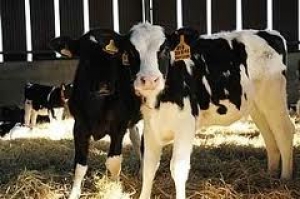Heifer care and management
Numerous Reports of Pneumonia in Growing Calves

Reproductive diseases
Abortion
Several centres reported sporadic abortions associated with fungal infections. Sutton Bonington investigated a typical incident. Mycotic abortion due to Aspergillus fumigatus was diagnosed in a sixmonth gestation fetus. Gross findings included multiple circular raised areas in the form of irregular elevated plaques in the fetal skin and the placenta showed necrotic cotyledons with intense reddening of the intercotyledonary areas. Fungal hyphae were detected on microscopic examination and Aspergillus fumigatus was isolated from the foetal stomach contents.

A Holstein-Friesian cow calved a normal bull calf and soon afterwards the farm worker found a spherical hairy mass in the pen. This amorphus globosus was approximately 11cm in diameter. It was covered in short black and white hair. An umbilical cord led into it and there was a further circular disruption in the surface that extended into a fluid filled cyst on the inside of the mass and was a likely early eye development. The cut surface was homogenous. Amorphus globosus is a type of acardic monster and thought to be an abnormal twin fetus.
Enteric diseases
Most centres diagnosed calf scour, dominated by cryposporidia and rotavirus, often in mixed infection. K99 (F5) positive Escherichia coli was isolated from the faeces of a three day old calf by Aberystwyth. Two calves had suffered acute diarrhoea with profound dehydration.
Respiratory diseases
Many laboratories reported pneumonia associated with mixed infections in growing calves. An 18- month-old Friesian heifer failed to respond to antibiotic following anorexia and laboured breathing. The group had been housed two weeks previously. At necropsy there was widespread fibrinous pleurisy and necrotic bronchopneumonia affecting all lung lobes. A heavy pure growth of Mannheimia haemolytica was cultured. There was no evidence of viral involvement from fluorescent antibody tests (FAT) and histopathology. Acute fatal Mannheimia infections are well recognised shortly after housing in this age of cattle.
Nervous diseases
Meningoencephalitis due to Histophilus somni was thought to be responsible for the death of a one year old Holstein Friesian heifer submitted to Carmarthen. The animal showed signs of blindness the morning of submission and quickly became recumbent, had increased respiratory distress and died shortly afterwards. It was homebred and was housed with a group of 11 others of similar age. Anterior lobe pneumonia was present and the meninges were congested. Histophilus somni was isolated in scant growth from the lung and from the brain. The clinical signs were consistent with the nervous form of H. somni infection in cattle.
Mastitis
Luddington investigated an ongoing problem with chronic mastitis cases in a 200-cow dairy herd, with a high bulk somatic cell count. Culture of the milk samples yielded a pure growth of Corynebacterium bovis in 5/8 samples; this is an occasional cause of mastitis and a high incidence is usually associated with suboptimal post milking teat disinfection. Accurate application with a good quality product was recommended.
Metabolic disease
An increasing number of stillborn and weak calves on a beef unit prompted the submission of blood samples to Starcross to investigate the problem. Biochemistry confirmed a significantly low pooled plasma inorganic iodine result, 71ng/ml (reference range 105-287 ng/ml). Marginal GSH-Px results were also detected. A similar clinical problem was investigated in a group of 20 dairy heifers of which five had produced a stillborn calf. As in the previous case both low iodine and GSH-Px results were identified.
Further Reading
Find out more information on the diseases mentioned in this report by clicking here.






















